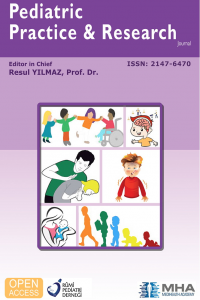Nadir Görülen Uzamış Yenidoğan Sarılığı Öyküsü
Sarılık yenidoğan bebeklerde sık görülen bulgulardan biridir. Normal fizyolojik bir durum olarak kabul edilir ve genellikle selim, geçici bir durumdur. Serum bilirubin düzeyi yaklaşık 6 mg/dl'nin üzerinde ise gözle görülebilir hale gelmektedir. Term bir bebekte 14 günden sonra devam eden hiperbilirubinemi, uzamış yenidoğan sarılığı olarak tanımlanmaktadır. Patolojik sarılık, gebelik haftası 35 ve üzerindeki bebeklerde serum total bilirubin değerinin bilirubin normogramında % 95 persentil ve üzerinde olması ile tanımlanır. Bebeklerin çoğunluğu benign ankonjuge hiperbilirubinemiye sahiptir. Ancak bu hastaların küçük bir grubunda morbidite ve/veya mortalite ile sonuçlanabilen konjuge hiperbilirubinemi ve karaciğer hastalığı vardır. Konjuge hiperbilirubinemi her zaman patolojiktir. Bu yazıda, uzamış neonatal sarılık yaklaşımı gözden geçirilmektedir.
A Rare Case of Prolonged Neonatal Jaundice
Jaundice is one of the most common problems in the newborn. It is generally accepted as a physiologic condition and most cases are benign and transient. Serum bilirubin level is above 6 mg/dl in newborns, jaundice is visible. Hyperbilirubinemia, which continues after a period of 14 days in a term neonate, is defined as prolonged neonatal jaundiced. Pathologic jaundice is defined as a bilirubin level above the 95 th percentile in infants larger than 35 gestational weeks. The vast majority of affected infants have a benign unconjugated hyperbilirubinemia. But in a small portion of this patients have conjugated hyperbilirubinemia and liver disease, which may cause morbidity and/or mortality. Conjugated hyperbilirubinemia in the newborn period is always pathologic. This present paper reviews the approach to the prolonged neonatal jaundiced.
___
- Referans 1. Hartley J. The Jaundiced Baby. In: Kelly DA, ed. Diseases of the liver and biliary system in children. 4th ed. Birmingham: John Wiley & Sons Ltd; 2017 p.99-126.
- Referans 2. Moyer V, Freese DK, Whitington, et al. North American Society for Pediatric Gastroenterology, Hepatology and Nutrition. Guideline for the evaluation of cholestatic jaundice in infants: Recommendations of the North American Society for Pediatric Gastroenterology, Hepatology and Nutrition. J Pediatr Gastroenterol Nutr 2004; 39: 115-28.
- Referans 3. Suchy FJ. Neoanatal Cholestasis. Pediatr Rev 2004; 25: 388-96.
- Referans 4. Aydoğdu S, Özgenç F, Atik T, Ünal F, Tokat Y, Yağcı RV. Biliary atresia in Turkish Children. Pediatr Int 2004; 46: 158-61.
- Referans 5. Demirbas D, Brucker WJ, Berry GT. Inborn Errors of Metobolism with Hepatopathy. Metabolism defects of Galactose, Fructose and Tyrosine. Pedıatr Clin North Am 2018; Apr 65: 337-352.
- Referans 6. Patel D, Teckman JH. Alpha-1-Antitrypsin Deficiency Liver Disease. Clin Liver Dis 2018; Nov 22: 643-55. doi: 10.1016/j.cld.2018.06.010. Epub 2018 Aug 22.
- Referans 7. Moyer K, Balistreri W. Hepatobiliary disease in patients with cystic fibrosis. Curr Opin Gastroenterol 2009; May; 25: 272-8.
- Referans 8. Andre N, Foquelaure B, Jubin V, Ovaert C. Succesful treatment of severe cardiomyopathy with NTBC in a child with tyrosinemia type I. J Inherit Metab Dis 2005; 28: 103-6.
- Referans 9. Meena BL, Khanna R, Bihari C, Rastogi A, Rawat D, Alam S. Bile duct pausity in childhood-spectrum, profile and outcome. Eur L Pediatr 2018 (Aug); 177: 1261-69. doi: 10.1007/s00431-018-3181-3. Epub 2018 Jun 4.
- Referans 10. Evason K, Bove KE, Finegold MJ, et al. Morphologic Findings in Progressive Familial Intrahepatic Cholestasis 2 (PFIC2): Correlation With Genetic and Immunohistochemical Studies. Am J Surg Pathol 2011; 35: 687–696.
- Referans 11. Tümgör G. Kolestaz ve Kaşıntı: Progresif Familyal İntrahepatik Kolestaz? J Curr Pediatr 2016; 14: 88-95.
- ISSN: 2147-6470
- Başlangıç: 2013
- Yayıncı: MediHealth Academy Yayıncılık
Sayıdaki Diğer Makaleler
Çocuklarda Kardiyojenik Şoka Güncel Yaklaşım
Cinsiyet Gelişim Bozukluklarında Cerrahi Yaklaşım
Dr.tamer SEKMENLİ, İlhan ÇİFTCİ
KRONİK PANKREATİT OLGUSUNDA AKRAN EĞİTİMİNİN ÖNEMİ
Ayşegül BÜKÜLMEZ, Melike TAŞDELEN BAŞ, Songül ARSLAN
Diyala Valiliğinde Gastroenteritli Çocuklarda İnsan Norovirüsünün Saptanması
Marwa DİRAA, Jalil İbrahim AL-EZZİ, Areej HUSSEİN
Ersen ERASLAN, Derya GÜZEL, Songül DOĞANAY, Ayhan TANYELİ, Mustafa Can GÜLER
Nadir Görülen Uzamış Yenidoğan Sarılığı Öyküsü
Meltem GÜMÜŞ, Halil Haldun EMİROĞLU
SEMPTOMDAN TANIYA; BİR ÇOCUK OLGUDA KANLI DIŞKILAMA
Anna Carina ERGANİ, Meltem GÜMÜŞ, Dr.tamer SEKMENLİ, Halil Haldun EMİROĞLU
